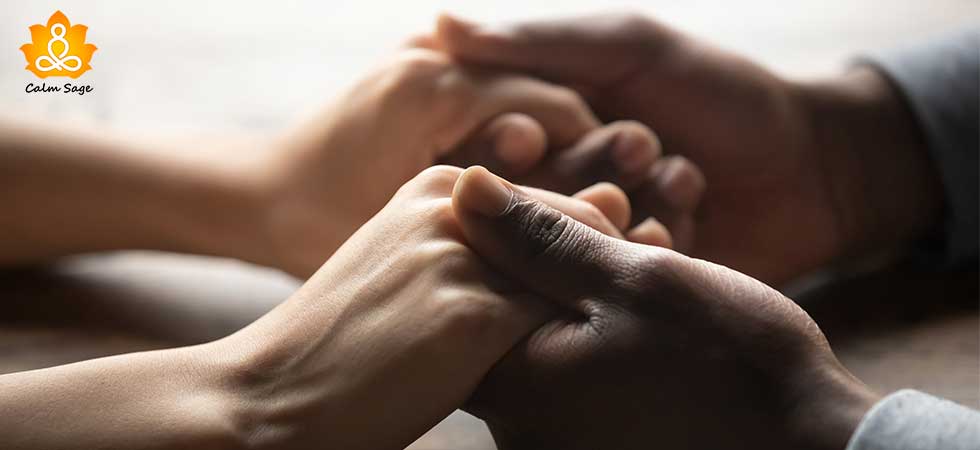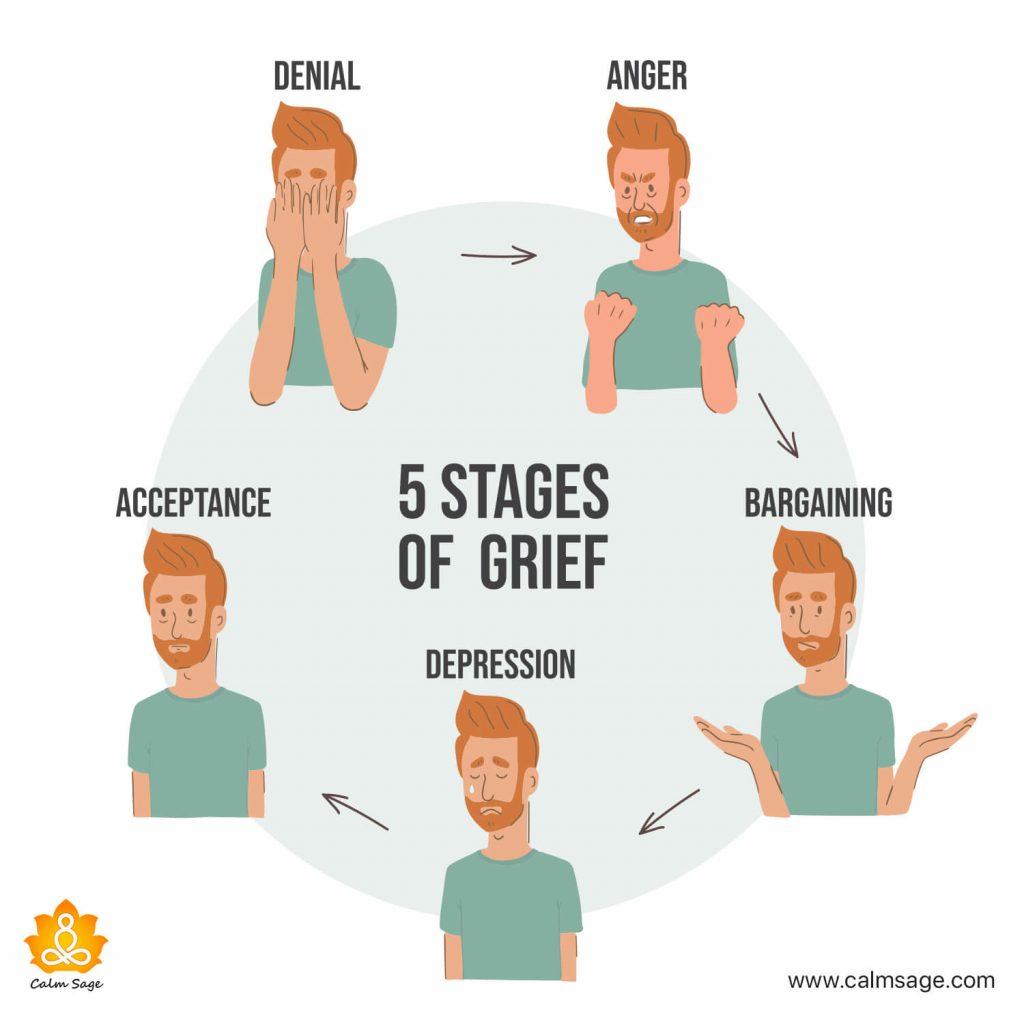The Five Stages of Grief :Be Your Own Healer

Grief is a very personal emotion and an equally intimate experience is mourning, one that definitely does not follow a linear or neat schedule. But, knowing what stage of grief you are in can help you cope with your emotions and create self-awareness to accept the emotion and the subsequent experience.
Grief is one of those emotions that you can deal with in the best manner with your own power and will. The external sources of support will be there but the ultimate healer of your grief is YOU!
To embrace this power from within it is important to accept that grief is not your whole life; it is a rough patch of life.
Elisabeth Kübler-Ross, the death-and-dying expert in 1969 tried to put this emotion in a cycle of phases that each one of us is likely to experience. However, this cycle is subject to individual variation.
Disclaimer: This grief cycle represents a generic pattern of reactions that we demonstrate when tragic news is disclosed. But, we don’t necessarily move through these stages one at a time, in a step-by-step or linear manner. We tend to move around between the stages.
The Kübler-Ross Stages Of Grief
The Kübler-Ross stages of grief include the five common emotional reactions:
- Denial
- Anger
- Bargaining
- Depression, and
- Acceptance
Grieving isn’t something that comes from coming to terms with your death or the loss of a loved one but this emotion – grief – can be experienced if you’re struggling with a chronic illness, break up of a long-term relationship, or even from the loss of your dreams.
No matter the situation or experience, grief is an emotion, too real that can manifest anytime. What I’m trying to say is that there is no reason to mourn or experience grief. What’s real is how you feel. And no matter how you feel, feelings can never be right or wrong.
Below, let’s take a look at the 5 stages of grief :

5 Stages of Grief in Psychology:
Stage 1: Denial
“This can’t be happening to me”
Grief comes unexpectedly in our lives, which calls for time to absorb and understand exactly what has happened. Contrary to the name, this stage is not about the inability to accept the loss that has taken place but is rather a coping mechanism that helps us to pace our feelings of grief. Once you start absorbing the news and begin to process it, the emotions that were being denied so far will come to life.
Examples:
“They’re not gone. They’ll come back soon.”
“They’re only upset with me. It’ll be okay in a few days.”
“It’s OK, I haven’t lost my job. They need me, they’ll call.”
Stage 2: Anger
“Why is this happening?”
When the reality of the loss starts coming to your conscious the associated emotions will too start hitting your gut. But, instead of showing these emotions as you experience them, anger hides them.
As a result, you may feel this anger at other people or even inanimate objects. With time, the anger starts to subside and rational thinking may swipe in, allowing you to feel the emotions you were keeping at bay for now.
Examples:
“If they had noticed the signs before, this wouldn’t have happened!”
“I hate them. It’s all their fault!”
“It’s a terrible workplace anyway. I hope their business fails!”
Stage 3: Bargaining
“If only I worked harder they would have kept me”
This stage is predominantly marked with “If” statements, giving your feelings of vulnerability a way to demonstrate themselves. We find ourselves bargaining in various contexts like- “God, if you let my pet live I will spend more time with them” or ‘If only I took them to the doctor earlier…’
The reason behind this bargaining is to avoid the current pain. Another aspect of this stage is focusing on self regrets and faults associated with our interactions with the person we have lost.
Examples:
“If only I was there with them that day, this wouldn’t have happened.”
“If only I had paid attention to them, they wouldn’t have left me.”
“If only I had worked harder to prove my worth, they wouldn’t have let me go.”
Stage 4: Depression
“I am too drained to do anything”
Often referred to as a quiet stage of grief unlike anger and bargaining (the active stages) is the starting point to looking at reality and accepting the present situation.
Certain important behavioral changes of this stage are- moving inward, being less sociable, talking less about our pain to others, and feeling overwhelmed overall. However, we start working with these emotions and behavior healthily as compared to the previous ones.
Examples:
“What can I do without them?”
“Why do anything at all?”
“It’s hopeless. I don’t know what to do anymore.”
Stage 5: Acceptance
“I am going to be okay”
As the word explains itself you start accepting the loss by this time. It doesn’t ask to move past the loss or grief; rather this stage is marked by your understanding of the grief and its meaning in your life.
It is a time to re-enter reality, calling forth adjustment and readjustment in the current life. You find your way forward, move on it, and grow above the loss.
Examples:
“I’m happy to have some good memories with them.”
“This was a good choice in the end.”
“I can’t change what happened but I can forge a new path from this point onwards.”
However, the stages of grief do not stop here. Did you know that there are additional 7 stages of grief that are a part of the grieving process? This adaptation and extension of the five stages of grief are often referred to as the Kübler-Ross Change Curve. The seven stages of grief can include the following.
7 Stages Of Grief: The Kübler-Ross Change Curve
1. Shock
The intense state of surprise and numbness over the loss. This stage can look a lot like, “They would not dare to do this. How can they do this!?”
2. Denial
The state of disbelief is similar to the first stage of the 5 stages of grief. This can look a lot like, “They wouldn’t do this. They’ll be back soon.”
3. Anger and Bargaining
This stage is a mix of anger and acknowledgment of things that have changed. You may lash out and blame while asking for anything to grant relief from the feelings of loss. It might look like, “If I’m given another chance, I’ll be a better person.”
4. Depression
This stage is when loneliness, isolation, and sadness are experienced. Quite similarly to the one in the five stages of grief. This can look like, “I might never move on from this loss. I have nothing to move on from.”
5. Adjustment
At this stage, the guilt, anger, and shock are no longer heavy and you begin to feel calm about the loss. This is also the stage where you may begin to adjust your life around the loss. This may look a lot like, “The loss was hard but maybe there’s still hope in the future. Maybe I shouldn’t give up just yet.”
6. Reconstruction
As the term suggests, you now begin to reconstruct your life and try to move on. There’s optimism about learning to manage your new reality. This may look like, “I need to figure out what went wrong and make changes.”
7. Hope
The last stage of the 7 stages of grief is about gradual acceptance and hope. You have accepted reality, have some hope, and are moving forward with your life. This stage may look a lot like, “I am aware of my weaknesses but I have still a lot to look forward to. I just need to keep the hope alive.”
The Common Myths About Grief And Mourning
Mourning for everyone can look different. It’s a unique and intimate experience that varies from person to person. What mourning might mean to you, doesn’t need to mean the same to others. Same as grief. Grief is a complex emotion and the experience of that emotion depends on the person.
Always remember that grief is never right or wrong. However you choose to grieve, it’s valid. Nonetheless, it doesn’t stop others from commenting and creating myths about grief. Here are some of the common myths about grief and mourning (and their truth):
- Everyone Has The Same Grieving Process
Absolutely not! One of the common myths about grief is that grieving is the same for everyone. When you’re coping with a loss, there’s no right or wrong way of coping. While others might comment saying, “You should be feeling….”, don’t pay them any attention.
What grieving might look like to them, doesn’t mean it’s the same for you. It’s a unique and personal journey towards healing.
- You Should Experience All The Stages Of Grief
Not everyone experiences all the stages of grief or experiences the emotions in stages. For some, the depression stage of grief can mean being irritable but for someone else, it might be sadness or hopelessness.
For some, the denial stage may be more of a shock than anything else. The emotions that might be expected in the stages of grief are not the only emotions you might experience. In many cases, some people may not experience the expected emotions at all. And it’s OK.
- There Should Be An Order To Mourning
No rule says that there should be an order to mourning. The stages of grief are not experienced in a linear order. Some people may experience the stages of grief one by one while others may go back and forth through the stages of grief.
Sometimes, you may feel intense sadness but the next day you might be hopeful. A few days later, you may feel sad again and some days you may feel sad and hopeful on the same day.
It’s OK. That’s a part of the grief process. Similarly, denial isn’t the stage that you might experience first. You may experience anger at first and later denial. It’s a normal part of the healing journey.
- Grief Is A Short-Term Experience
Coping with a loss is a personal and intimate experience but it doesn’t mean that it’s a short-term experience. While for some people, grieving may last for weeks but for others, it might last longer than a few weeks. There’s no timeline to grief. You can read how we learn to grow around grief with this theory here.
- You Are Depressed
The depression stage of grief isn’t equal to clinical depression. There’s a difference between these two experiences even though the symptoms might be the same.
For instance, when grieving, the sadness felt during the depression stage may eventually lessen and you might even feel sad while feeling happy by remembering good memories.
When it’s clinical depression, things are different. Your mood might worsen with time and your self-esteem may go down. Without treatment, finding happiness in small things might not be possible.
You can develop depression during your grieving and if your emotions increase in intensity and frequency, then you might want to reach out for professional help.
When And How To Seek Help?
If you’re going through a mourning period and experiencing the stages of grief, then you can reach out for help to make the coping process easier.
You can find help if you’re wanting a smooth transition in the following cases:
- You need to go back to school or work and are having a hard time focusing on your daily tasks.
- You’re the sole support for someone.
- You’re experiencing physical pain.
- You’re skipping healthy habits because you don’t feel like doing anything.
- Your emotions are increasing in intensity and frequency.
- You are thinking about hurting yourself.
For immediate help, you can reach out to:
- National Suicide Prevention Lifeline at 1800-273-8255, or
- Text HOME to the Crisis Text Line at 741741.
You can also reach out to your friends and family as talking to them might give you a sense of relief. When you open up about your feelings with someone you trust, it can help cope with difficult emotions.
You can also reach out to grief support groups online or offline. Support groups can be a good option if you want to reach out for help.
Connecting with others going through similar situations can help you come to terms with your emotions as well. Additionally, support groups are a safe space where you can express yourself without feeling pressured or judged.
Another good way to reach out for help is through grief counseling. With grief therapy, you can connect with professionals who can help support your grieving process.
Book Your First Therapy Session Here
How To Help Your Grieving Loved One?
If your loved one – a friend, a family member, or a coworker – has experienced a recent loss, then you can help them with their grieving process by:
1. Listening to their experiences.
While you may want to comfort them with words, in some cases, just being there as silent support can be enough. Make sure they know that you’re there for them and listen to their experience whenever they want to share. Also, do not force them to open up, give them time and space.
2. Being practical.
You can help your loved ones by finding ways to help them with their daily tasks. Explore and ask what they might need help with and offer them help while they process their loss. You can shop for groceries or clean their room. Small things will matter.
3. Avoid assumptions.
It’s OK to offer comfort with words but make sure you don’t assume which stage of grief they are going through. If they are smiling, it does not mean they are not mourning. If they are resuming their normal activities does not mean that they are not depressed. Let them express their feelings (when they feel ready) and support them from there.
4. Providing resources.
While you may provide them comfort by being there, there are times when your loved ones need more than a friendly shoulder to lean on. To help them, you can offer them resources.
Make sure you don’t force them to use these resources. Know that they will use them when they feel the need. Having the information on hand is a great help too.
Frequently Asked Questions (FAQs)
Q: How long does it usually take to go through the stages of grief?
Grief is a unique experience and varies from person to person. There is no timeline for grief or grieving. You may take days or weeks in the same stage of grief or you may even skip one or all stages of grief. There’s no set time to grieve. You can take as long as you need.
Q: Is it normal to still grieve after 6 months?
While grief does not have a timeline, experiencing grief beyond 6 months can be a criterion for prolonged grief disorder. At this point, you may need a psychiatric or bereavement evaluation. You may also want to consider evaluation for major depressive disorder or PTSD.
Q: How do you know when you have stopped grieving?
When you begin to think about your lost person, pet, or thing as a happy memory rather than a painful absence, then it can be a sign that you’re healing from the loss. Grieving never stops but the pain of loss you once felt might be lesser than it once was.
Q: Can you skip stages of grief?
Yes, you can. While you may remain at one stage of grief for a prolonged period, at other times, you may even skip the stages of grief entirely. It’s normal but remember that grief and grieving do not have to be right or wrong. The experience is unique to you.
Wrap Up
The reason why knowing and understanding these stages is important to start the healing process is that it makes you realize that everyone has their journey of grief and you have your own. It allows you to accept what you are going through thus aiding in vetting out your feelings.
Grief is a weighty emotion to deal with.
A Professional Therapist Can Help
Advice: If the grief persists or you need help coping with these feelings then, seeking mental health advice is recommended. This will further give you a sense of assurance to deal with this heavy emotion.
Little by little we let go of loss… but never of love…
More Power to You…
Take Care!




















